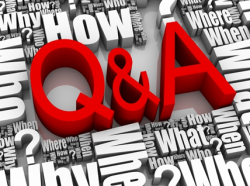A Better Way to Q and A
I’ve watched many good presentations go down in flames because of a poorly handled question and answer session. One outstanding example was a young man who was presenting his team’s new business proposal to the organization’s leadership group. The presentation was well organized and confidently delivered. Finally the speaker wrapped up with a good call-to-action and asked for questions. Most of the questions were clarifications on the team’s recommendations which the speaker answered competently but others were more challenging and you could tell that he was struggling a bit. After a good number of questions, he stated that he had time for one more question. In the back row the divisional VP raised her hand and was called on. “So if we give you and your team the resources you’re asking for and the project fails, are you willing to take full responsibility?” she asked. Well you could see the color drain from his face and he stumbled through a half-hearted answer. Then he shrugged his shoulders as his close and walked out of the room with the rest of his team. Results – the project didn’t get funded and the team members ended up working on other assignments. Now I don’t know if that decision was a result of how he answered this final question but it certainly didn’t help. Here are some ways that you can more effectively deal with questions during a presentation.
Make Your Presentation Interactive: Forcing your audience to wait until the end of a presentation can be a disaster. I have always likened it to a volcanic eruption! The longer they have to wait to ask a question or get clarification, the more antagonistic those questions can become. By allowing your audience to participate throughout your presentation, their anxiety is released and they feel validated and appreciated. However, these interruptions could be a challenge for the less experienced presenter if they were to put him or her off track from their planned topics.
Prepare and Anticipate Questions: In the example above the presenter should have anticipated some of the tough questions and been ready with answers. Very few speakers take the time to understand and prepare for the types of questions their talk will engender. If you use a test audience as part of your preparation, they will be able to give you a realistic set of questions from which you can build your Q & A session.
Put a Limit on the Questions: Whether it’s a time limit, “I have five minutes for questions.” or a maximum number of questions, “I have time for 3 questions.”, it is useful to restrict the number of questions. This will allow you to keep the process short so as not to bore a majority of your audience and keep the questions from becoming too absurd as the audience has time to get more creative.
Maintain Eye Contact with the Whole Audience: One of the challenges of a Q & A session is that it can become a series of private conversations between the speaker and the questioner. To keep this from happening (and losing the majority of your audience), have eye contact with the questioner only at the beginning and end of the process. So it looks like this: Question being asked – eye contact with the questioner. Answering the question – make eye contact with the whole audience. Confirming that the question was answered – focus back on the questioner.
Stay Relaxed: I still have the video of a presentation class I took early in my career. During a question and answer session I had my fists balled up and was in a fighting posture! It’s really funny to look at now, but I think that many presenters are looking for a fight. What I mean is they think the questions will be antagonistic, so they act in a defensive manner and so the questions get more and more aggressive. It’s a self-fulfilling situation. Relax and assume the questions will be friendly, then you will handle them as such and the audience will remain cordial.
Save Your Best Close for After the Q & A: As in our opening example, the speaker used his best close as he went into his Q & A session. Instead he should have summarized the talk, held the Q & A session, then closed with his best material. We never know how the questions will go and ending on a bad answer can hurt our presentation. Having a good close allows you to control the final message that the audience hears and makes sure it is positive and inspirational.
By necessity the question and answer session takes place at the end of our presentations. By effectively preparing and controlling the atmosphere, we increase the chances of a successful presentation.
© Copyright 2014. Reach Development Systems. Powered by TechBoss Designs
